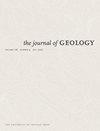基于贝叶斯理论和高斯Copula的三种构造背景下辉长岩判别数学模型
IF 1.3
4区 地球科学
Q2 GEOLOGY
引用次数: 4
摘要
通过火成岩的化学成分来区分构造环境是一种可行的地球化学方法。分析了辉长岩判别构造环境的可行性,建立了基于高斯copula和贝叶斯理论的数学模型,对岛弧、海岛和洋中脊三种构造环境进行了判别。该模型的推导包括三个步骤:(1)确定不同构造环境中元素的概率密度函数(PDF);(2)使用copula函数确定不同构造背景下岩石地球化学成分的联合PDF;(3)使用贝叶斯理论确定岩石的构造环境。利用遗传算法计算数学模型的最佳参数,最终确定了以TiO2、Al2O3、FeOT、CaO、MnO、K2O、Na2O、Ni和Sr九种基本元素为基本元素的数学模型的最终形式。实验表明,数学模型在三种构造环境下的成功率分别为84.03%、95.48%和91.84%。平均成功率为92.13%,显著高于使用判别图和朴素贝叶斯算法。这样一个理想的结果表明,利用辉长岩来确定构造环境的类型是可行的。此外,该研究可以为机器学习和数学方法在地球化学领域的应用提供支持。本文章由计算机程序翻译,如有差异,请以英文原文为准。
A Mathematical Model Based on Bayesian Theory and Gaussian Copula for the Discrimination of Gabbroic Rocks from Three Tectonic Settings
Discriminating among tectonic settings by the chemical composition of igneous rocks is a feasible method in geochemistry. In this study, the feasibility of using gabbroic rocks to discriminate among tectonic settings is analyzed, and a mathematical model based on Gaussian copula and Bayesian theory is set up to discriminate among three tectonic settings: island arc, ocean island, and mid-oceanic ridge. The derivation of the model includes three steps: (1) determine the probability density functions (PDFs) of the elements in different tectonic settings, (2) determine the joint PDFs of the geochemical components of the rocks from different tectonic settings using copula functions, and (3) determine the tectonic settings of rocks using Bayesian theory. The optimal parameters of the mathematical model are calculated using a genetic algorithm, and finally the definitive form of the model is determined with nine basic elements: TiO2, Al2O3, FeOT, CaO, MnO, K2O, Na2O, Ni, and Sr. An experiment shows that the success rates of the mathematical model on the three tectonic settings are 84.03%, 95.48%, and 91.84%, respectively. The average percent success rate is 92.13%, which is significantly higher than using discrimination diagrams and the naive Bayes algorithm. Such an ideal result indicates that using gabbroic rocks to determine the types of tectonic settings is feasible. Moreover, this study can provide support for the application of machine learning and mathematical methods in the field of geochemistry.
求助全文
通过发布文献求助,成功后即可免费获取论文全文。
去求助
来源期刊

Journal of Geology
地学-地质学
CiteScore
3.50
自引率
5.60%
发文量
0
审稿时长
3 months
期刊介绍:
One of the oldest journals in geology, The Journal of Geology has since 1893 promoted the systematic philosophical and fundamental study of geology.
The Journal publishes original research across a broad range of subfields in geology, including geophysics, geochemistry, sedimentology, geomorphology, petrology, plate tectonics, volcanology, structural geology, mineralogy, and planetary sciences. Many of its articles have wide appeal for geologists, present research of topical relevance, and offer new geological insights through the application of innovative approaches and methods.
 求助内容:
求助内容: 应助结果提醒方式:
应助结果提醒方式:


